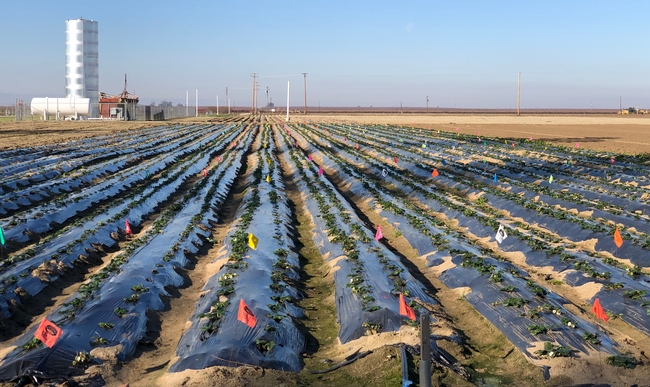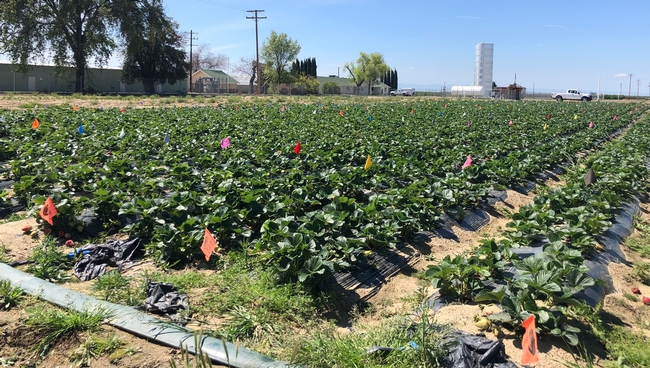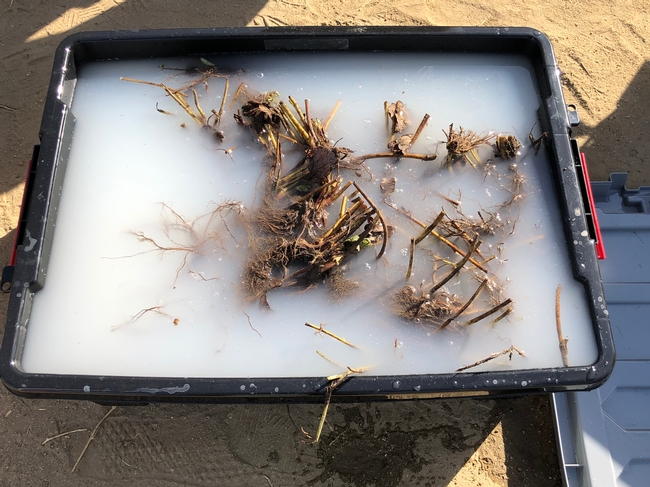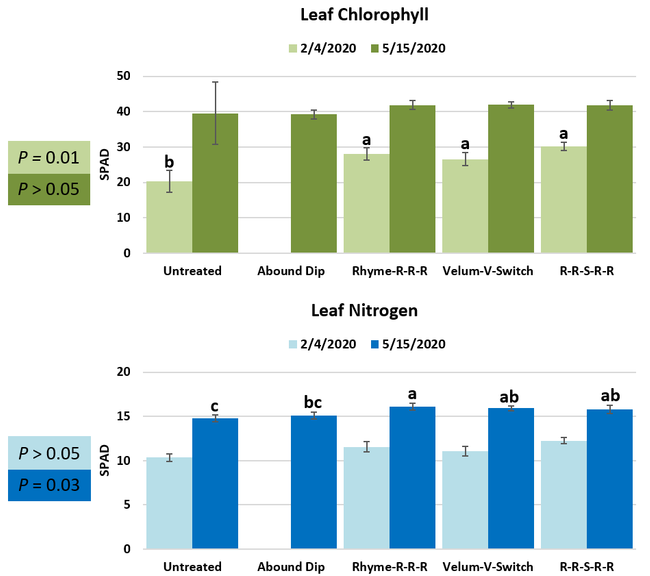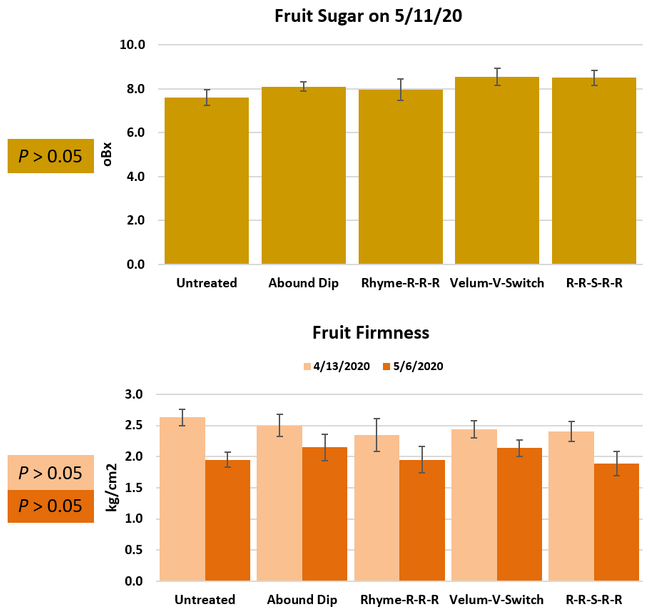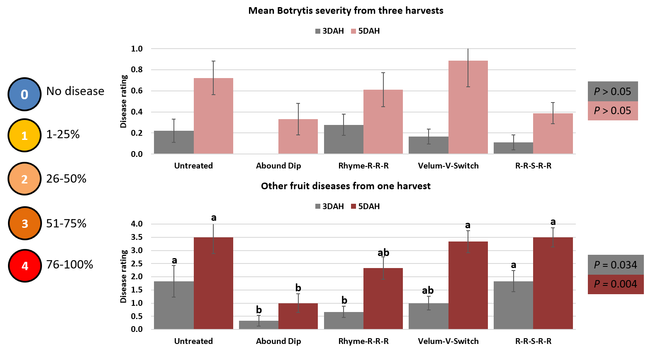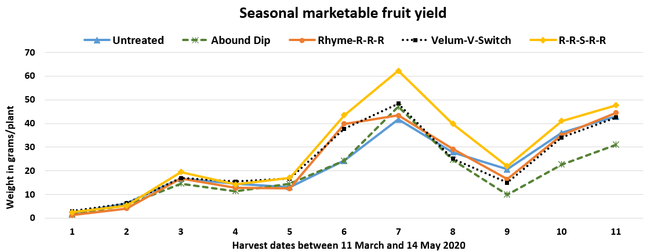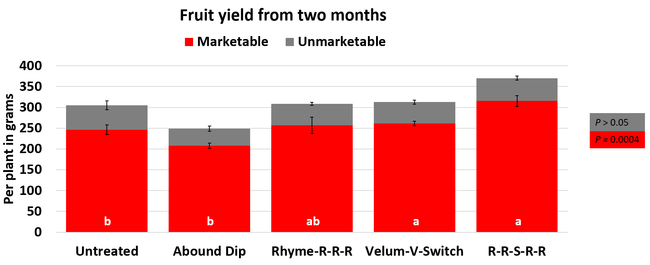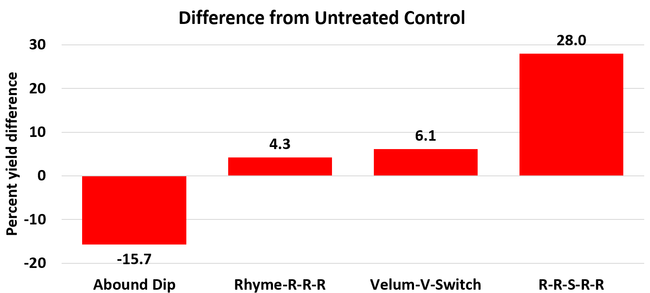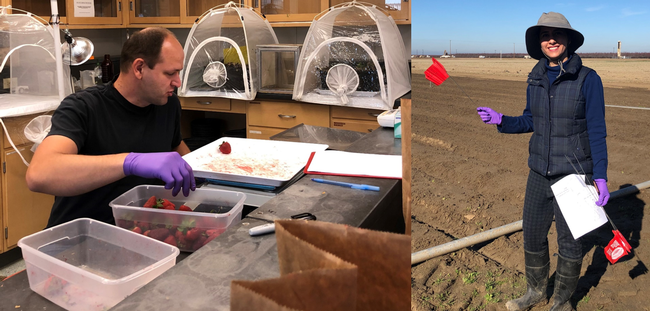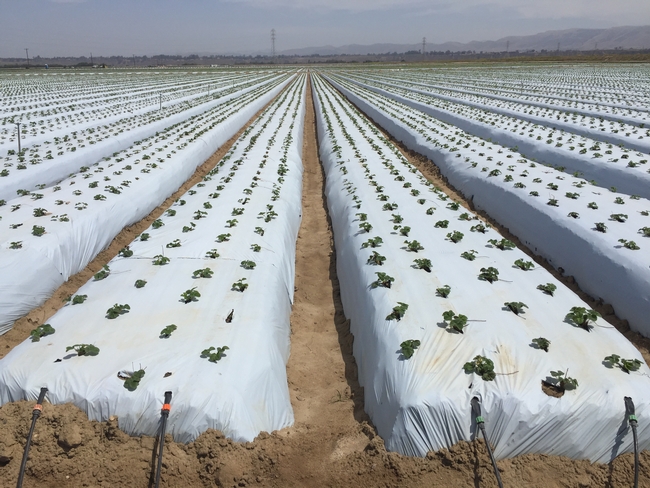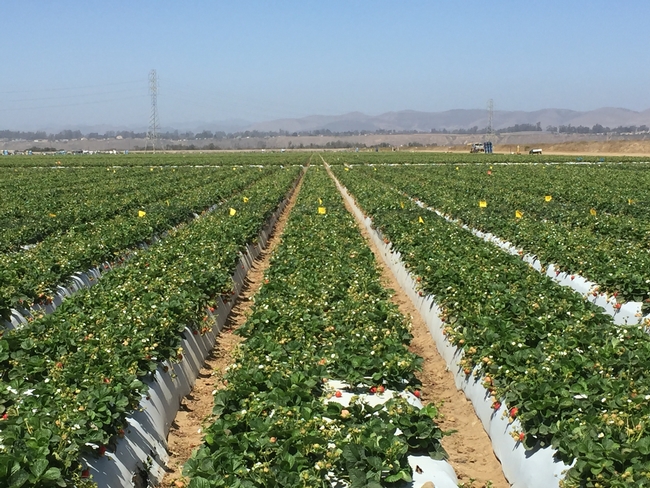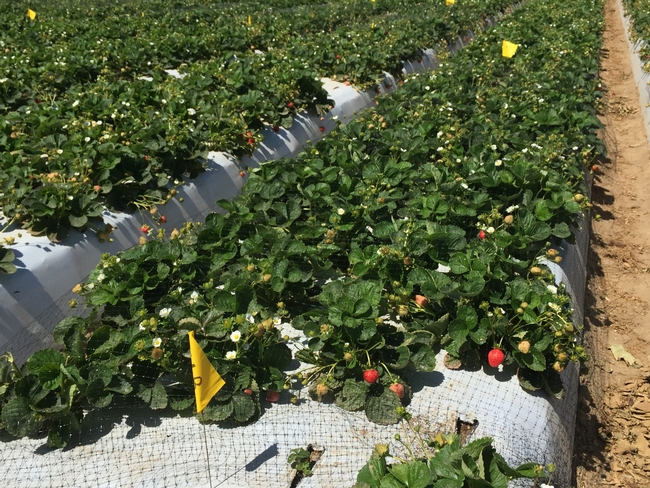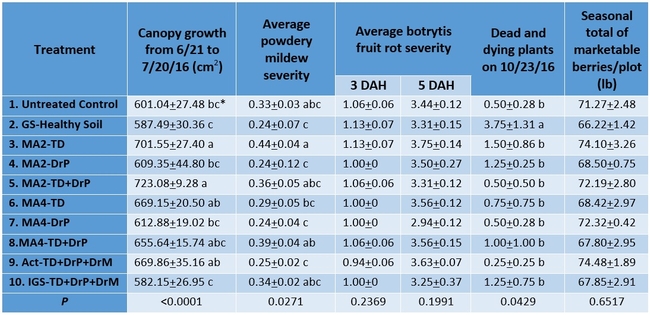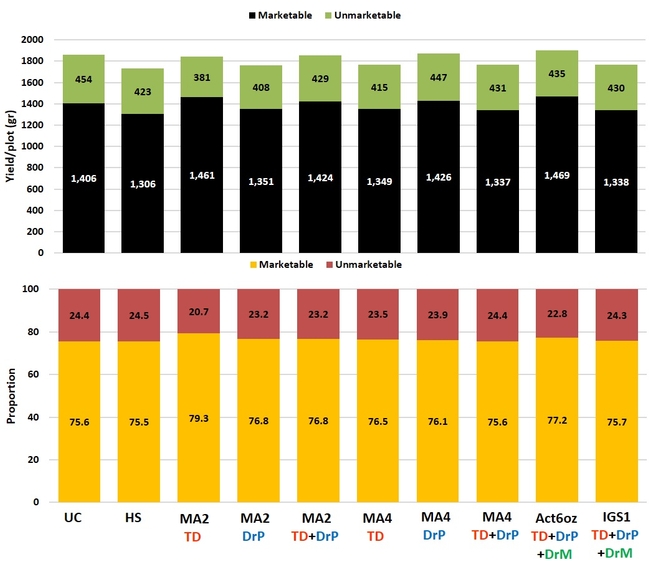- Author: Surendra K. Dara
Strawberry, a high-value specialty crop in California, suffers from several soilborne, fruit, and foliar diseases. Verticillium wilt caused by Verticillium dahliae, Fusarium wilt caused by Fusarium oxysporum f. sp. fragariae, and Macrophomina crown rot or charcoal rot caused by Macrophomina phaseolina are major soilborne diseases that cause significant losses without proper control. Chemical fumigation, crop rotation with broccoli, nutrient and irrigation management to minimize plant stress, and non-chemical soil disinfestation are usual control strategies for these diseases. Botrytis fruit rot or gray mold caused by Botrytis cineaea is a common fruit disease requiring frequent fungicidal applications. Propagules of gray mold fungus survive in the soil and infect flowers and fruits. A study was conducted to evaluate the impact of drip application of various fungicides on improving strawberry health and enhancing fruit yields.
Methodology
This study was conducted in an experimental strawberry field at the Shafter Research Station during 2019-2020. Cultivar San Andreas was planted on 28 October 2019. No pre-plant fertilizer application was made in this non-fumigated field which had Fusarium wilt, Macrophomina crown rot, and Botrytis fruit rot in the previous year's strawberry planting. Each treatment was applied to a 300' long bed with single drip tape in the center and two rows of strawberry plants. Sprinkler irrigation was provided immediately after planting along with drip irrigation, which was provided one or more times weekly as needed for the rest of the experimental period. Each bed was divided into six 30' long plots, representing replications, with an 18' buffer in between. Between 6 November 2019 and 9 May 2020, 1.88 qt of 20-10-0 (a combination of 32-0-0 urea ammonium nitrate and 10-34-0 ammonium phosphate) and 1.32 qt of potassium thiosulfate was applied 20 times at weekly intervals through fertigation. Treatments were applied either as a transplant dip or through the drip system using a Dosatron fertilizer injector (model D14MZ2). The following treatments were evaluated in this study:
i) Untreated control: Neither transplants nor the planted crop was treated with any fungicides.
ii) Abound transplant dip: Transplants were dipped in 7 fl oz of Abound (azoxystrobin) fungicide in 100 gal of water for 4 min immediately prior to planting. Transplant dip in a fungicide is practiced by several growers to protect the crop from fungal diseases.
iii) Rhyme: Applied Rhyme (flutriafol) at 7 fl oz/ac immediately after and 30, 60, and 90 days after planting through the drip system.
iv) Velum Prime with Switch: Applied Velum Prime (fluopyram) at 6.5 fl oz/ac 14 and 28 days after planting followed by Switch 62.5 WG (cyprodinil + fludioxinil) at 14 oz/ac 42 days after planting through the drip system.
v) Rhyme with Switch: Four applications of Rhyme at 7 fl oz/ac were made 14, 28, 56, and 70 days after planting with a single application of Switch 62.5 WG 42 days after planting through the drip system.
Parameters observed during the study included leaf chlorophyll and leaf nitrogen (with chlorophyll meter) in February and May; fruit sugar (with refractometer) in May; fruit firmness (with penetrometer) in April and May; severity of gray mold (caused by Botrytis cinereae) twice in March and once in May, and other fruit diseases (mucor fruit rot caused by Mucor spp. and Rhizopus fruit rot caused by Rhizopus spp.) once in May 3 and 5 days after harvest (on a scale of 0 to 4 where 0=no infection; 1=1-25%, 2=26-50%, 3=51-75% and 4=76-100% fungal growth); and fruit yield per plant from 11 weekly harvests between 11 March and 14 May 2020. Leaf chlorophyll and nitrogen data for the Abound dip treatment were not collected in February. Data were analyzed using analysis of variance in Statistix software and significant means were separated using the Least Significant Difference test.
Results and Discussion
Leaf chlorophyll content was significantly higher in plants that received drip application of fungicides compared to untreated plants in February while leaf nitrogen content was significantly higher in the same treatments during the May observation. There were no differences in fruit sugar or average fruit firmness among the treatments.
The average gray mold severity from three harvest dates was low and did not statistically differ among the treatments. However, the severity of other diseases was significantly different among various treatments with the lowest rating in Abound transplant dip on both 3 and 5 days after harvest and only 3 days after harvest in plants that received four applications of Rhyme. Unlike the previous year, visible symptoms of the soilborne diseases were not seen during the study period to evaluate the impact of the treatments. However, there were significant differences among treatments for the marketable fruit yield. The highest marketable yield was observed in the treatment that received Rhyme and Switch followed by Velum Prime and Switch and Rhyme alone. The lowest fruit yield was observed in Abound dip treatment. Unmarketable fruit (deformed or diseased) yield was similar among the treatments. Compared to the untreated control, Abound dip resulted in 16% less marketable yield and such a negative impact from transplant dip in fungicides has been seen in other studies (Dara and Peck, 2017 and 2018; Dara, 2020). Marketable fruit yield was 4-28% higher where fungicides were applied to the soil.
Although visible symptoms of soilborne diseases were absent during the study, periodic drip application of the fungicides probably suppressed the fungal inocula and associated stress and might have contributed to increased yields. The direct impact of fungicide treatments on soilborne pathogens was, however, not clear in this study due to the lack of disease symptoms. Considering the cost of chemical fumigation or soil disinfestation and the environmental impact of chemical fumigation, treating the soil with fungicides can be an economical option if they are effective. While this study presents some preliminary data, additional studies in non-fumigated fields in the presence of pathogens are necessary to consider soil fungicide treatment as a control option.
Acknowledgments: Thanks to FMC for funding this study and Marjan Heidarian Dehkordi and Tamas Zold for their technical assistance.
References
Dara, S. K. 2020. Improving strawberry yields with biostimulants and nutrient supplements: a 2019-2020 study. UCANR eJournal of Entomology and Biologicals. https://ucanr.edu/blogs/blogcore/postdetail.cfm?postnum=43631
Dara, S. K. and D. Peck. 2017. Evaluating beneficial microbe-based products for their impact on strawberry plant growth, health, and fruit yield. UCANR eJournal of Entomology and Biologicals. https://ucanr.edu/blogs/blogcore/postdetail.cfm?postnum=25122
Dara, S. K. and D. Peck. 2018. Evaluation of additive, soil amendment, and biostimulant products in Santa Maria strawberry. CAPCA Adviser, 21 (5): 44-50.
- Author: Surendra K. Dara
- Author: Dave Peck, Manzanita Berry Farms
Various soilborne, fruit and foliar diseases can affect strawberry crop and fruit yields. Chemical fumigants and a variety of fungicides are typically used for managing the disease issues. In addition to the environmental and human health concerns with chemical control options there is a need to improve current disease management with alternatives that include beneficial microbes. Previous studies showed some promise with some of the treatments, but additional studies are required to evaluate the efficacy, which is more evident especially when there is disease incidence.
A study was conducted in summer-planted conventional strawberries in 2016 at Manzanita Berry Farms to evaluate the impact of various beneficial microbial treatments on plant growth, health, and fruit yield. Untreated control and the grower standard practice (Healthy Soil treatment) were compared with MycoApply EndoMaxx (Glomus intraradices, G. aggregatum, G. mosseae, and G. etunicatum), Actinovate AG (Streptomyces lydicus WYEC 108), and Inocucor Garden Solution (Saccharomyces cerevisiae and Bacillus subtilis) applied in the following treatments:
1. Untreated control
2. Grower Standard-Healthy Soil; transplant dip in Switch 62.5WG 5 oz in 100 gal
3. MycoApply EndoMaxx 2 gpa transplant dip (TD)
4. MycoApply EndoMaxx 2 gpa drip at planting (DrP)
5. MycoApply EndoMaxx 2 gpa transplant dip + 2 gpa drip at planting
6. MycoApply EndoMaxx 4 gpa transplant dip
7. MycoApply EndoMaxx 4 gpa drip at planting
8. MycoApply EndoMaxx 4 gpa transplant dip + 4 gpa drip at planting
9. Actinovate AG 6 oz/ac transplant dip + 6 oz drip at planting + 6 oz drip monthly (DrM)
10. Inocucor Garden Solution 1 gpa drip at planting + 1 gpa drip monthly
Transplanting was done on 21 May, 2016 with appropriate treatments administered at the time of planting and thereafter. Study had two blocks of 10 strawberry beds (300' long) and treatments were randomly applied to a bed within each block. Two 15' long plots were marked within each bed for sampling. Canopy growth was measured on June 21, July 5 and 20; powdery mildew severity on August 3, September 1, October 10 and November 16; botrytis severity 3 and 5 days after harvest (DAH) for berries harvested on September 13 and 27, and October 11 and 18; and dead and dying plants were counted on September 16 and October 23. Yield data were collected from August 20 to November 18. Powdery mildew and botrytis fruit rot severity was measured on a scale of 0 to 4 where 0=No disease, 1=1-25%, 2=26-50%, 3=51-75%, and 4=76-100% severity. Data were analyzed and means were separated using LSD test.
Strawberry field and plots on June 9 (above) and August 31 (below).
Two sampling plots were set up within each bed to collect plant growth, health, and yield data.
Canopy growth: MycoApply EndoMaxxat 2 gpa either as a transplant dip with or without drip application at planting appeared to promote significantly higher growth (P <0.0001) than MycoApply EndoMaxx at 2 and 4 gpa as drip at planting, untreated control, and grower standard. Inoculating the entire transplant with Glomus spp. through a dip appears to be better than application through drip irrigation system.
Powdery mildew: Disease incidence and severity was low during the observation period. When the average of four observations period was compared, the grower standard, MycoApply Endomaxx at 2 and 4 gpa as drip at planting, and the Actinovate treatments had the lowest incidence (P = 0.0271).
Botrytis fruit rot: There was no difference (P >0.05) among the treatments on botrytis when the mold growth on fruit was compared 3 and 5 days after harvest.
Unknown issue: Some wilting and dead plants were found throughout the field during the study. Although symptoms suggested some kind of wilt, laboratory testing did not identify any pathogens. The total number of dead and dying plants was the lowest in Actinovate treatment, but it was significantly different (P = 0.0429) only from the grower standard Healthy Soil treatment.
*Means followed by the same or no letter are not significantly different at the P value indicated in the table.
Fruit yield: There were no statistically significant difference among the treatments and the seasonal total of marketable yield varied between 66 lb/plot in the grower standard and about 76 lb/plot in MycoApply EndoMaxx applied as a transplant dip at 4 gpa.
Total and marketable berry yields and their proportion among different treatments.
We need to continue to evaluate beneficial microbial products and their potential benefit in improve crop health and yields.
Acknowledgements: Thanks to Chris Martinez and Tamas Zold for technical assistance, and Valent USA and Inocucor Technologies for the financial support of the study.


